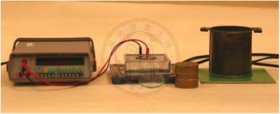TELDAP Collections
| Heat Conduction |
|
Heat transfers because of temperature gradient, resulting in mutual exchange of heat energy within single object or among several. When the temperatures in two objects are not the same, heat energy always transfers from the one of high temperature to that of low temperature. The philosophy behind it is the transfer of kinetic energy because forces act among the atoms and molecules. The purpose of this experiment is to study the transfer of heat and determine the rate of heat conduction. Also, practice the principle of thermal couples in the experiment.
Multimeter
Video Heat Conduction
|













